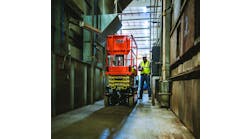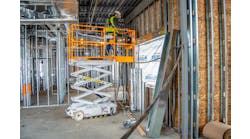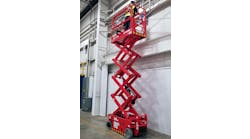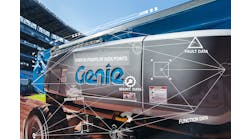RER: Tell us about new technological developments on your equipment?
Christensen: We’re launching a new lift model, called the FS105-Z, which is a combined articulating and telescoping compact lift type with record-setting performance for its category. It will in particular be targeted against outdoor applications, where you have the combination between limited access, large outreach and significant work height. However, it is also equipped with batteries for indoor use, so it can be used indoor as well.
What are some of the trends you expect to see in the coming years in aerial equipment?
Well, being in a niche field of the industry as the market leader for compact lifts, I have the privilege to observe the market in a different way than producers of so-called main stream products like boom and scissor lifts. I believe that we will see an increased focus on specialty products, being it compact lifts or tall truck-mounted lifts.
We’ve seen a significant de-fleeting from the rental industry over the past year, and the market is still seeing more supply than demand on the traditional lift products. Consequently, the rental industry must look for new venues for revenue, and I think we will see some change in directions in the aerial rental industry. But, eventually, as always it will equally depend on the suppliers of specialty equipment and their ability to adapt and understand the needs of the rental business, and cater to those needs in a manner where they just don’t act as vendors, but if you like, partners as it will require a closer cooperation.
In terms of the rental market, we hope we may be seeing something of a recovery in the second half of this year and going into 2011. What are your expectations for the economy?
We all hope that the small light we see at the end of the tunnel after the first half of the year truly is the end, and not another oncoming train. I expect the economy to continue to slowly improve over the second half, and we’ve seen strong signals in the market that some level of optimism is back. I do believe the mid-term elections in November will be the deal maker or breaker as far as 2011 goes. Said in non-partisan way, I believe it is necessary to create a better political balance in Congress in order to obtain stability, which will bring the financial players back into the ring.
What types of equipment do you recommend for rental fleets as we go into, hopefully, a recovery? And why?
As commented above, the specialty products offer new segments that so far are undeveloped. Typically the ROI is higher on specialty products, but of course, typically so is the cost.
What are some of the improvements and new developments your customers have been asking for in your equipment?
Aside from the usual desire to get more for less, I think customers more than before are looking for the best equipment for the job, not just from an application point of view, but also a safety point of view. The customers expect that we as vendors look at their needs and from there design our product portfolio. In tough times you often see consolidation mode, i.e., manufacturers are cutting down on number of models in an effort to rationalize the production. While everyone can understand why, in reality it is forcing the customers to, so to speak, adapt accordingly. In essence it should be the other way around, in particular in a service-driven market.
So, we try to accommodate our customers by keeping a large product range, which short term may be a little more or less efficient for the bottom line, but long term we are able to continue to provide optimal solutions. As we all know, the right lift for the right job improves safety, which should be any lift manufacturer’s number one concern.
What are some of most important regulatory developments – in terms of aerial safety – currently and how do they play into where you are going in your technology?
It is a sensitive subject as regulations are often seen as an obstacle to free enterprise, but when it comes to aerial safety, it is a vital subject. In terms of specific regulatory developments, we still need more strict legislation for the most basic safety issues, such as wearing safety harnesses and fall-protection equipment, not to mention proper training requirements. Every year hundreds of fatalities are caused by use of ladders in situations where either a lift or a scaffold should have been used.
Some European countries like the Netherlands has, in recent years, implemented quite strict legislation as far as the use of ladders, and it will be interesting to see how that plays out in the statistics as far as accidents related to use of ladders. Today the customer has a long range of compact aerial equipment that wasn’t available just five years ago, so I see it more as a natural evolution rather than restrictive regulations only. At the end of the day we all share the same goal – customers and vendors – to create a safer work environment.
What areas of aerial safety are you most concerned with right now and what is your company doing in the safety area?
The first thing that comes to mind is training. With a far margin, most accidents today are caused by the operator, not the equipment. We require people to get a license to drive a car, but we don’t think it is important to get a license to operate a piece of equipment that will take you 100+ feet in the air? It doesn’t make any sense.
We have for years operated our own training program for our equipment, we are members of IPAF and its American affiliate AWPT. We are working on becoming one of an expanding group of IPAF-approved training centers in an effort to expand our own training. Secondly, I think it is time for some revisions of the ANSI standards, which have long been overtaken by the development of equipment. We see entire segments of the industry --compact, self-propelled lifts being one -- not even remotely being covered by standards, and instead everyone has to try to adapt to the closest standard. It translates into situations where, for example, the safety inspections performed may conform to ANSI standards, but not the equipment. In other words, entire areas of a lift are not observed, and if a customer decides to go by the OSHA and ANSI regulations only they may overlook important safety issues.
What types of improvements would you most like to see when it comes to aerial work platform safety practices in the rental industry?
I think the most important issue would be the training, but one that also includes the vendors. I don’t see the training issue being the responsibility of the rental industry only, it is indeed also a key issue for the manufacturers, and we need to be better to help our customers – here the rental industry – to move forward as a partner. That’s why we’re looking into the IPAF system, and I think we will see a higher level of interaction between the parties in the years to come.





